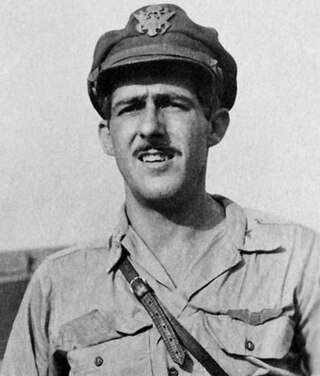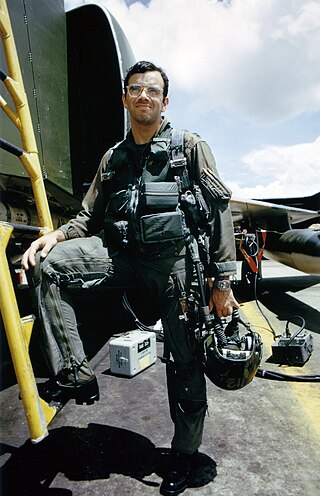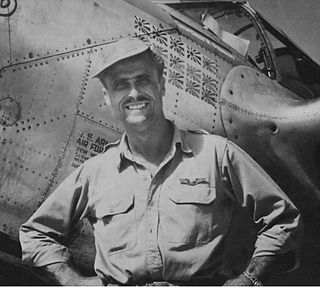
Richard "Dick" Ira Bong was a United States Army Air Forces major and Medal of Honor recipient in World War II. He was one of the most decorated American fighter pilots and the country's top flying ace in the war, credited with shooting down 40 Japanese aircraft, all with the Lockheed P-38 Lightning fighter. He died in California while testing a Lockheed P-80 jet fighter shortly before the war ended. Bong was posthumously inducted into the National Aviation Hall of Fame in 1986 and has several commemorative monuments named in his honor around the world, including an airport, two bridges, a theater, a veterans historical center, a recreation area, a neighborhood terrace, and several avenues and streets, including the street leading to the National Museum of the United States Air Force in Dayton, Ohio.

General John Charles Meyer was an American World War II flying ace, and later the commander-in-chief of the Strategic Air Command (SAC) and director of the Joint Strategic Target Planning Staff at Offutt Air Force Base, Nebraska. SAC was the United States' major nuclear deterrent force with bombers, tankers and reconnaissance aircraft, and intercontinental ballistic missiles. The Joint Strategic Target Planning Staff coordinated the nation's nuclear war plans and developed the Single Integrated Operations Plan.

Thomas Buchanan McGuire Jr. was an American United States Army major who was killed in action while serving as a member of the United States Army Air Forces during World War II and posthumously awarded the Medal of Honor. He was one of the most decorated American fighter pilots and the second highest scoring American ace of the war.

Marmaduke Thomas St John Pattle,, usually known as Pat Pattle, was a South African-born English Second World War fighter pilot and flying ace of the Royal Air Force (RAF).

The 1st Operations Group is the flying component of the 1st Fighter Wing, assigned to the USAF Air Combat Command. The group is stationed at Langley Air Force Base, Virginia. The 1st Operations Group is the oldest major air combat unit in the United States Air Force, being the successor organization of the 1st Pursuit Group. The 1st Pursuit Group was the first air combat group formed by the Air Service, American Expeditionary Force, on 5 May 1918.

Jeffrey S. Feinstein is a retired career officer of the United States Air Force (USAF). During the Vietnam War, Feinstein was a weapon systems officer, an integral part of two-man aircrews with the emergence of air-to-air missiles as the primary weapons during aerial combat. Flying aboard F-4 Phantom IIs, Feinstein downed five enemy aircraft, thereby becoming a flying ace, the last of five U.S. aviators to become aces during that conflict and to date still the most recent aviator to achieve ace status in the U.S. military.

George Earl Preddy Jr. was a United States Army Air Forces officer during World War II and an American ace credited with 26.83 enemy air-to-air kills, ranking him as the top P-51 Mustang ace of World War II and eighth on the list of highest scoring American aces.

Colonel Charles Henry "Mac" MacDonald was a United States Air Force officer and a fighter ace of World War II. MacDonald commanded the 475th Fighter Group for 20 months in his P-38 Lightning, "Putt Putt Maru", and became the third ranking fighter ace in the Pacific during World War II.

The 49th Fighter Group was a fighter aircraft unit of the Fifth Air Force that was located in the Asiatic-Pacific Theater during World War II.

Charters Towers Airport is an airport located in Columbia, Charters Towers, Queensland, Australia, 2.9 nautical miles north of the Charters Towers CBD.

The 53rd Weapons Evaluation Group is a United States Air Force unit that reports to the 53rd Wing. It is stationed at Tyndall Air Force Base, Florida. The unit is part of Air Combat Command.

Colonel John Simon Loisel was an American air ace, credited with having shot down 11 Japanese aircraft during World War II. Loisel was born in Coeur d'Alene, Idaho and joined the United States Army Air Forces in 1941. By age 25, Loisel had spent more time in combat than any other American pilot in World War II, with over three years in the Pacific. Serving in the Pacific he quickly distinguished himself by first becoming an ace after achieving five kills in just a two-month period, and then becoming a double ace.

William Thomas Whisner Jr. was a career officer and pilot in the United States Air Force, retiring as a colonel with 30 years of military service. He was a fighter ace with Army Air Forces over Europe in World War II and a jet fighter ace with the Air Force in the Korean War.

Gerald Richard Johnson was a World War II flying ace who flew for the United States Army Air Forces. Johnson commanded the 9th Fighter Squadron and 49th Fighter Group, and became the fourth ranking fighter ace in the Pacific during World War II. He ended his war career with 22 kills.

Thomas Joseph Lynch was a United States Army Air Forces lieutenant colonel and a flying ace of World War II. After joining the United States Army Air Corps in 1940, Lynch flew the Bell P-39 Airacobra with the 39th Pursuit Squadron. After the attack on Pearl Harbor, the squadron was deployed to Australia and then to Port Moresby in early 1942.

Robert Burdette Westbrook was a United States Army Air Forces lieutenant colonel and a World War II flying ace. Westbrook commanded the 44th Fighter Squadron, and became the leading fighter ace of the Thirteenth Air Force. He is also the ninth ranking fighter ace in the Pacific during World War II and also one of ten United States Army Air Forces pilots who became an ace in two different types of fighter aircraft.

Robert William Foy was a United States Army Air Forces fighter pilot and triple-ace who was credited with 15 aerial victories during World War II.
John Dave Landers was a colonel in the United States Army Air Forces. He flew with the 9th Fighter Squadron in the Pacific commanded the 357th Fighter Group and the 78th Fighter Group during World War II.

Abner Maurice Aust Jr. was an American flying ace in the 506th Fighter Group during World War II, and a career fighter pilot in the United States Air Force. During World War II, Aust flew Very Long Range (VLR) fighter missions from Iwo Jima and was one of the last pilots to become flying aces in the war. During Vietnam War, Aust commanded two fighter wings and flew more than 300 combat missions.

Thomas Lloyd Hayes Jr. was a United States Army Air Forces flying ace during the World War II. He accrued 8.5 victories in the war.
























